Welcome to Unst: the special island at the end of Britain
Britain’s most northerly inhabited island is one of the most spectacular, varied and interesting in Europe. Unst has everything that attracts visitors to Shetland – and a little bit more.
Packed into an area just 12 miles long by five miles wide are stupendous cliffs, jagged sea stacks, sheltered inlets, golden beaches, heathery hills, freshwater lochs, peat bogs, fertile farmland – and even a unique, sub-Arctic, stony desert.
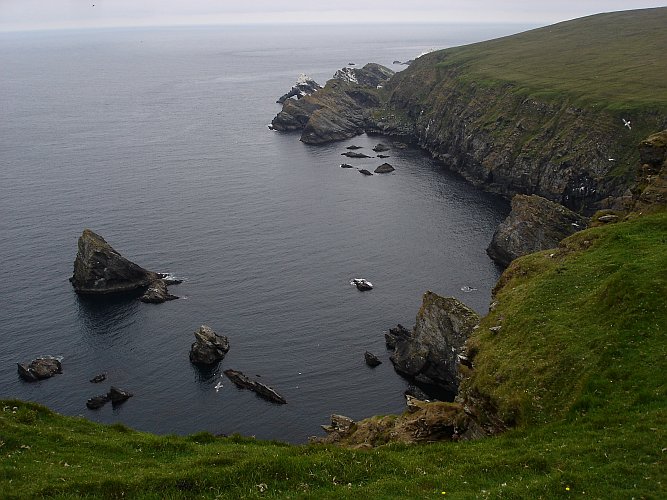 Cliffs at Unst
Cliffs at Unst
 This intricate landscape supports a rich variety of wildlife, as well as pure bred Shetland sheep and ponies which roam the common grazing land. Here you can meet Unst’s world-famous Shetland Ponies at the roadside. Unst is a major European breeding site for seabirds, including Gannets, Puffins, Guillemots, Razorbills, Kittiwakes and Shags, and for moorland-nesting rarities such as Great Skuas, Arctic Skuas and Whimbrels.
This intricate landscape supports a rich variety of wildlife, as well as pure bred Shetland sheep and ponies which roam the common grazing land. Here you can meet Unst’s world-famous Shetland Ponies at the roadside. Unst is a major European breeding site for seabirds, including Gannets, Puffins, Guillemots, Razorbills, Kittiwakes and Shags, and for moorland-nesting rarities such as Great Skuas, Arctic Skuas and Whimbrels.
Seals abound, Porpoises are common, and you may even see the shy Otter or a pod of passing Killer Whales.
Unst is an ideal place to enjoy bird-watching, botany, geology, archaeology, walking, sailing, angling or traditional music – or just to enjoy the peace and quiet.
There is evidence of the early Norse settlers both in the place names and archaeology. Unst has the greatest density of rural Viking longhouses currently known. The Viking Unst project is excavating examples at Hamar and Belmont. They aim to try and answer key questions about when the Vikings arrived in Shetland, how they fitted with the existing population, and how they lived when they got here. Visitors are welcome and, when the excavations are in progress, the archaeologists will explain what they are doing.
Unst is also a very sociable community that welcomes visitors to local events such as the farmers market, annual show, Up-Helly-Aas, fishing competitions, regattas, concerts, musical events and dances.
As well as the great outdoor attractions of birdwatching at Hermaness National Nature Reserve, rare plants on the Keen of Hamar, clean sandy beaches, wonderful coastal walks and sea and loch angling, there’s plenty on offer if the weather keeps you indoors.
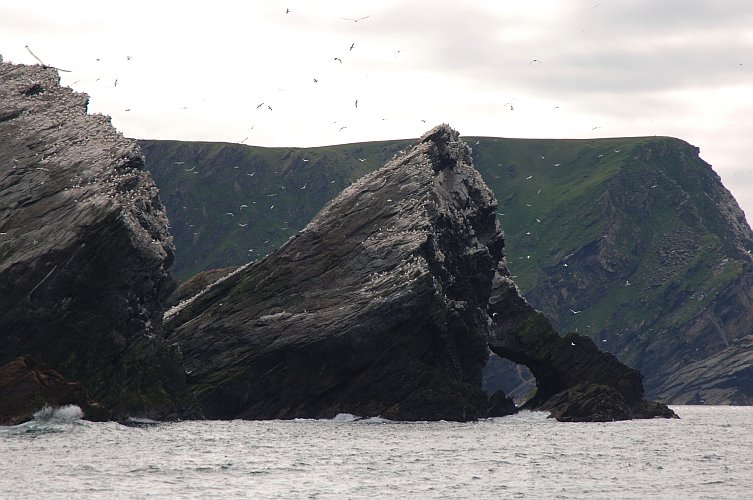 Unst cliffs - home to a variety of wildlife
Unst cliffs - home to a variety of wildlife
 The Unst Boat Haven is Shetland’s only museum dedicated to the history of the islands’ distinctive wooden boats and the line-fishermen who used them until the early 20th century. Modern pleasure-boats can be seen at the Unst Marina in Baltasound along with the Far Haaf, a locally-built replica of a sixareen (six-oared boat).
The Unst Boat Haven is Shetland’s only museum dedicated to the history of the islands’ distinctive wooden boats and the line-fishermen who used them until the early 20th century. Modern pleasure-boats can be seen at the Unst Marina in Baltasound along with the Far Haaf, a locally-built replica of a sixareen (six-oared boat).
Unst Heritage Centre tells the engrossing story of the islanders’ struggle for existence over the centuries.
Most Unst families are still involved with the traditional crofting life depicted here, but there’s a variety of other work based on the island’s resources and position, such as quarrying, fish farming, brewing, craftwork (fine knitwear in particular), renewable energy, and wildlife tourism.
Other indoor attractions include the leisure centre, knitwear shop, brewery and chocolate manufacturers. We hope you enjoy your visit to this remarkable, accessible and welcoming island.
South Unst
As the ferry from Yell crosses Bluemull Sound, you pass a modern salmon farm on the right hand side, on the left Hoganess and the ruins of one of Unst’s several brochs – circular fortresses built about 2,000 years ago.
You land below Belmont House, an 18th century landlord’s mansion, which is currently being restored by The Belmont Trust. Nearby, Shetland Ponies graze at the roadside. The walk from Belmont to Lund takes you past the deserted crofting townships of Snarravoe and Snabrough. Another fine walk is from Belmont around the south-western corner of Unst to the picturesque village of Uyeasound, a busy centre for fish farming.
Uyeasound, a short drive from Belmont, has a youth hostel. Next to the pier is Greenwell’s Booth, a warehouse once used by German Hanseatic merchants who dominated Shetland’s trade until the early 18th century.
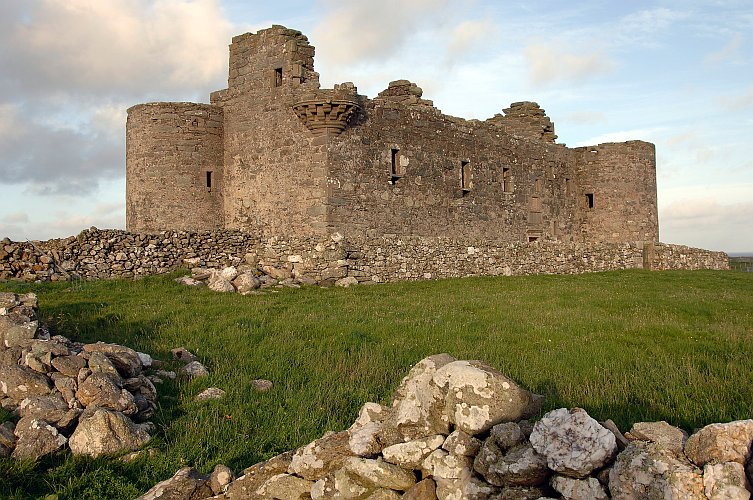 Muness Castle
Muness Castle
 To the east, one of Unst’s two prehistoric standing stones is by the road to Muness Castle, a 16th century fortified house open to the public. Also at Muness is a knitwear shop serving teas.
To the east, one of Unst’s two prehistoric standing stones is by the road to Muness Castle, a 16th century fortified house open to the public. Also at Muness is a knitwear shop serving teas.
A walk from Muness north to the Easting brings you to the perfect sandy beach of Sandwick, where a Viking longhouse has been excavated and again covered in sand.
Between Uyeasound and Baltasound, a detour down the Westing side road reveals some of Shetland’s prettiest scenery. The standing stone at Bordastubble is reputedly Shetland’s largest. At Underhoull there is the remains of another Viking house, below a broch overlooking the secluded beach at Lund. Beyond the ‘haunted house’ of Lund is the ruined 12th century kirk of St Olaf, with the tombstones of two German merchants and of Thomas Mouat who built Belmont.
Further along the Westing road is one of the many disused watermills, once used to grind oats and barley. Vallafield, the ridge dividing the Westing from the trout Loch of Watlee, has one of Shetland’s finest panoramas.
Central Unst and Baltasound
During the herring boom years, 1880-1925, Baltasound’s population of 500 rose to almost 10,000 during the season with the influx of the gutters and coopers.
Today the village has two shops, Britain’s most northerly post office (where postcards can be specially franked), a brewery, hotel, marina and a leisure centre with a heated swimming pool for those cold, rainy days.
Points of interest in the area include: prehistoric cairns on the hill of Crussafield; the ruins of Baliasta Kirk, near the side road to the Loch of Cliff; the lonely valley and boulder beach of Woodwick (where semi-precious stones are found); and the old horse-powered mill at Hagdale, a 19th century iron chromate mine.
Traces of old mines and quarries dot the hills north of Baltasound. At Quoys, near the salmon hatchery, is a disused talc quarry.
On the eastern side of Baltasound, is a unique botanical site – The Keen of Hamar National Nature Reserve. This desert look-alike supports a number of rare plants including Edmondston’s Chickweed, which is found nowhere else in the world but Unst.
At the junction for the Keen of Hamar look out for the Unst Bus Shelter, comfortably furnished with a sofa, table, curtains, computer and a range of accessories depending on the current theme!
North Unst
The village of Haroldswick, a couple of miles north of Baltasound, is home to the Unst Boat Haven – a unique collection of traditional Shetland fishing craft – and the fascinating Unst Heritage Centre, where the permanent displays include geology, genealogy and the island’s famous fine lace knitting and spinning. Both centres are open daily, May to September.
The Skidbladner, situated at Brookpoint is a full-size replica of the Gokstad ship found in Norway.
Haroldswick is also a good place to watch for seals and otters, particularly at low tide. On the eastern side of the village, Britain’s only working talc mine is at Clibberswick, known also for its Viking soapstone quarry.
Whilst the RAF left the station at Saxa Vord after keeping watch over the northern approaches for over 50 years, in 2006 the site was brought back to life as a tourist resort offering self-catering accommodation, 26 bedroom hostel, and lounge bar and restaurant and the Saxa Vord Resort. Foords Handmade Chocolates and the local Valhalla Brewery are also located at Saxa Vord.
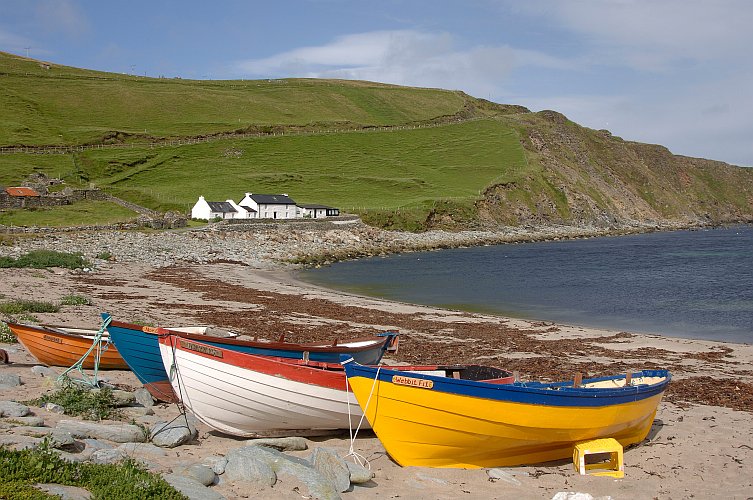 Norwick Beach
Norwick Beach
 North-east of Haroldswick, a single-track road leads to the beach and dunes of Norwick and on to Britain’s northernmost inhabited house, at Skaw. On the nearby headland of Lambaness are the ruins of a wartime radar station.
North-east of Haroldswick, a single-track road leads to the beach and dunes of Norwick and on to Britain’s northernmost inhabited house, at Skaw. On the nearby headland of Lambaness are the ruins of a wartime radar station.
Saxa Vord looks out over Burrafirth, the stacks of Muckle Flugga Lighthouse and the Out Stack – the full stop at the end of Britain.
The side road from Haroldswick to Burrafirth opens a panorama of dramatic cliffs, the wide, sandy links at the head of the inlet, and the dark waters of the Loch of Cliff.
The Scottish National Heritage Visitor Centre based in the former lighthouse shore station at Burrafirth, provides a great opportunity for those who are unable to make the walk to the cliffs to learn about the seabirds of Hermaness.
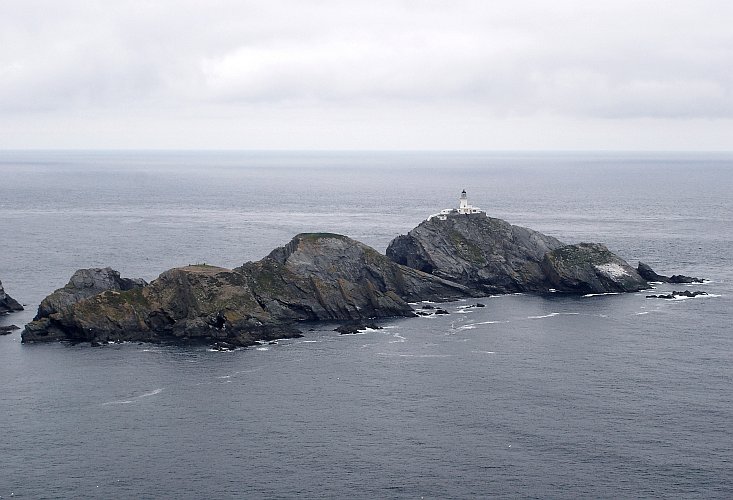 Muckle Flugga Lighthouse
Muckle Flugga Lighthouse
 The world-famous reserve covers the Muckle Flugga rocks and Out Stack as well as the seabird cliffs and moorland of Hermaness. It is home to over 100,000 seabirds in the breeding season.
The world-famous reserve covers the Muckle Flugga rocks and Out Stack as well as the seabird cliffs and moorland of Hermaness. It is home to over 100,000 seabirds in the breeding season.
The view of Muckle Flugga and the ocean from Hermaness is breathtaking. The lighthouse, now unmanned and remotely-controlled, was built by Robert Louis Stevenson’s father, Thomas, in 1857-8. The map in Treasure Island closely resembles a map of Unst which the writer saw on his visit to the island in 1869.
Getting to Unst
Although Unst is as far north as southern Greenland, it’s a very accessible island. Frequent vehicle ferries link the Shetland mainland to Unst via the neighbouring island of Yell. The ferries are very busy in summer and if travelling by car you are strongly advised to book by phoning the ferry office.
From Lerwick it’s a 45-minute drive north on the main A970 road to Toft ferry terminal. Follow the signs for the North Isles. The crossing to Yell takes 20 minutes. When you arrive at Ulsta in Yell, follow the main road to the Gutcher ferry terminal (about half an hour’s drive) for the 10-minute crossing to Unst.
There’s a daily bus service (except Sundays) from Lerwick to Unst, all year round. It leaves the Viking Bus Station in Lerwick and collects passengers at the Holmsgarth ferry terminal – connecting with ferry arrivals from Aberdeen. It is advisable to check all ferry and bus timetables before travelling.
Loganair’s inter-island planes connect with flights from the UK mainland landing at Sumburgh Airport, and also from Lerwick (Tingwall Airport) and other islands in the group. The Sumburgh – Unst flight is a great way to see a panorama of the islands.
If you bring your own boat, there’s a fine natural harbour at Baltasound, where a new pier and marina welcome visiting craft.
Some Useful Information
| Further Information on Unst: | www.unst.org |
| Ferry Booking Office: | Ulsta, Yell, Tel: 01957 722259 |
| Air Booking Office: | Tingwall Airport, Tel: 01595 840246 |
| Neighbourhood Information Point: | Heritage Centre and Haroldswick, Tel: 01957 711528 |
| Shops: | Baltasound |
| Fuel: | Baltasound |
| Public Toilets: | Belmont, Uyeasound, SNH Visitor Centre (Burrafirth) |
| Places to Eat: | Haroldswick, Baltasound, Muness, Saxa Vord |
| Post Office: | Baltasound |
| Public Telephones: | Uyeasound, Baltasound and Haroldswick |
| Leisure Centre: | Baltasound, Tel: 01957 711577 |
| Churches: | Haroldswick, Baltasound and Uyeasound |
| Doctor: | Baltasound, Tel: 01957 711318 |
| Police: | Baltasound, Tel: 01957 71142 |


